八年级新目标上Unit-7-How-do-you-make-a-banana-milk-shake教案
- 格式:doc
- 大小:407.50 KB
- 文档页数:30
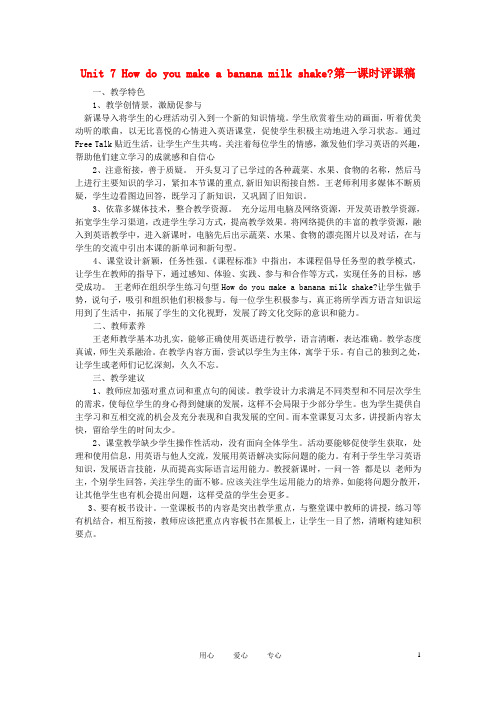
Unit 7 How do you make a banana milk shake?第一课时评课稿一、教学特色1、教学创情景,激励促参与新课导入将学生的心理活动引入到一个新的知识情境。
学生欣赏着生动的画面,听着优美动听的歌曲,以无比喜悦的心情进入英语课堂,促使学生积极主动地进入学习状态。
通过Free Talk贴近生活,让学生产生共鸣。
关注着每位学生的情感,激发他们学习英语的兴趣,帮助他们建立学习的成就感和自信心2、注意衔接,善于质疑。
开头复习了已学过的各种蔬菜、水果、食物的名称,然后马上进行主要知识的学习,紧扣本节课的重点,新旧知识衔接自然。
王老师利用多媒体不断质疑,学生边看图边回答,既学习了新知识,又巩固了旧知识。
3、依靠多媒体技术,整合教学资源。
充分运用电脑及网络资源,开发英语教学资源,拓宽学生学习渠道,改进学生学习方式,提高教学效果。
将网络提供的丰富的教学资源,融入到英语教学中,进入新课时,电脑先后出示蔬菜、水果、食物的漂亮图片以及对话,在与学生的交流中引出本课的新单词和新句型。
4、课堂设计新颖,任务性强。
《课程标准》中指出,本课程倡导任务型的教学模式,让学生在教师的指导下,通过感知、体验、实践、参与和合作等方式,实现任务的目标,感受成功。
王老师在组织学生练习句型How do you make a banana milk shake?让学生做手势,说句子,吸引和组织他们积极参与。
每一位学生积极参与,真正将所学西方语言知识运用到了生活中,拓展了学生的文化视野,发展了跨文化交际的意识和能力。
二、教师素养王老师教学基本功扎实,能够正确使用英语进行教学,语言清晰,表达准确。
教学态度真诚,师生关系融洽。
在教学内容方面,尝试以学生为主体,寓学于乐。
有自己的独到之处,让学生或老师们记忆深刻,久久不忘。
三、教学建议1、教师应加强对重点词和重点句的阅读。
教学设计力求满足不同类型和不同层次学生的需求,使每位学生的身心得到健康的发展,这样不会局限于少部分学生。
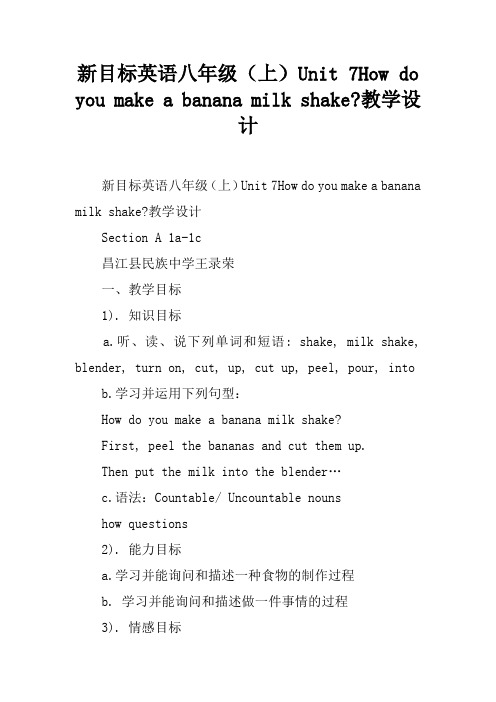
新目标英语八年级(上)Unit 7How do you make a banana milk shake?教学设计新目标英语八年级(上)Unit 7How do you make a banana milk shake?教学设计Section A 1a-1c昌江县民族中学王录荣一、教学目标1). 知识目标a.听、读、说下列单词和短语: shake, milk shake, blender, turn on, cut, up, cut up, peel, pour, intob.学习并运用下列句型:How do you make a banana milk shake?First, peel the bananas and cut them up.Then put the milk into the blender…c.语法:Countable/ Uncountable nounshow questions2). 能力目标a.学习并能询问和描述一种食物的制作过程b. 学习并能询问和描述做一件事情的过程3). 情感目标培养学生积极参与活动、团结合作的精神;体会烹饪的乐趣。
二、教学重点1)词汇:shake, milk shake, blender, turn on, cut, up, cut up, peel, pour, into2)句型:How do you make a banana milk shake?First, peel the bananas and cut them up.Then put the milk into the blender…三、教学难点利用所学的语言知识来描述一种食物的制作过程。
六、教学过程Step1 GreetingStep2 Leading inT: Look at the picture. What can you see in the picture? What’s it about?Step3 Presentation1. T: Look at the picture again. How does he makea banana milk shake?Lead out the new phrases and target languages.How do you make a banana milk shake?First, peel the bananas and cut them up.Then put the milk into the blender…(Teach: turn on, cut up, drink, peel, pour, put.)2.Check the answers3.Practice the phrases and the target languages.Step 4 PracticeLook at the picture and work in pairs.1)e.g A: How do you make a banana milk shake?B: First, peel the bananas…2) Ask some pairs to act out their conversations.Step 5 listeningListen and put the instructions in the correct order..1) The first time, only listen.2) The second time, listen and put the instructions in the correct order.3) Check the answers. Write numbers (1-6)Step 6 Group workTalk about how to make a banana milk shake in group of four.The other groups Ss: How do you make a banana milk shake?S1: First, peel three bananas.S2: Second, cut up the bananas.S3: Third, put the bananas and ice cream into the blender.S4: Fourth, pour the milk into the blender.Step 5 Exercises1. A: How do you make a banana milk shake?B: First, three bananas.Second, the bananas.Third,the bananas and ice cream into the blender.Fourth, the milk into the blender.Fifth, the blender.Finally, the milk shake.Step 6 Summary.Step 7 HomeworkRemember the recipe.Try to write out the recipe about how to make an apple milk shake。
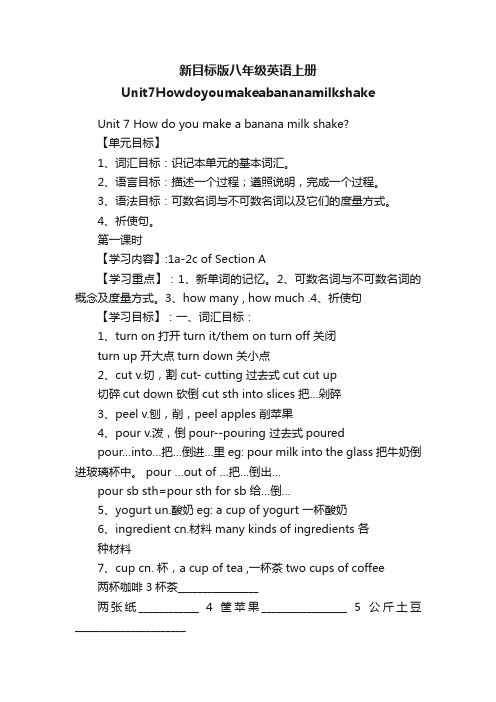
新目标版八年级英语上册Unit7HowdoyoumakeabananamilkshakeUnit 7 How do you make a banana milk shake?【单元目标】1、词汇目标:识记本单元的基本词汇。
2、语言目标:描述一个过程;遵照说明,完成一个过程。
3、语法目标:可数名词与不可数名词以及它们的度量方式。
4、祈使句。
第一课时【学习内容】:1a-2c of Section A【学习重点】:1、新单词的记忆。
2、可数名词与不可数名词的概念及度量方式。
3、how many , how much .4、祈使句【学习目标】:一、词汇目标:1、turn on打开turn it/them on turn off 关闭turn up 开大点turn down 关小点2、cut v.切,割 cut- cutting 过去式cut cut up切碎cut down 砍倒 cut sth into slices 把…剁碎3、peel v.刨,削,peel apples 削苹果4、pour v.泼,倒pour--pouring 过去式pouredpour…into…把…倒进…里eg: pour milk into the glass 把牛奶倒进玻璃杯中。
pour …out of …把…倒出…pour sb sth=pour sth for sb 给…倒…5、yogurt un.酸奶eg: a cup of yogurt 一杯酸奶6、ingredient cn.材料 many kinds of ingredients 各种材料7、cup cn. 杯,a cup of tea ,一杯茶two cups of coffee两杯咖啡 3杯茶________________两张纸____________ 4筐苹果_________________ 5公斤土豆______________________8、watermelon cn.西瓜,many watermelons 许多西瓜9、teaspoon cn. 茶匙a teaspoon of honey 一茶匙蜂蜜three teaspoons of yogurt 三茶匙酸奶10、amount n.数量(用来修饰不可数名词), a large amountof money一大笔钱与number的区别:eg:The number of books is100000.A number of books are here. 11、instruction cn.命令,指示,用法说明,aninstruction for the medicine药品的说明,somesuggestions for…,……的解决办法,a ticket forthe concert,一张音乐会的票, the recipe for thefood ,食物的做法,the solution for the problem 问题的解决办法,the answer to the question 问题的答案,the key to the door 门的钥匙。
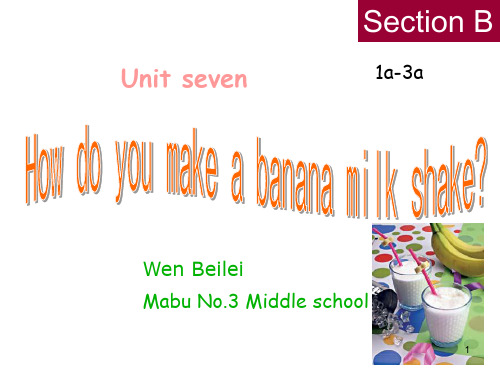
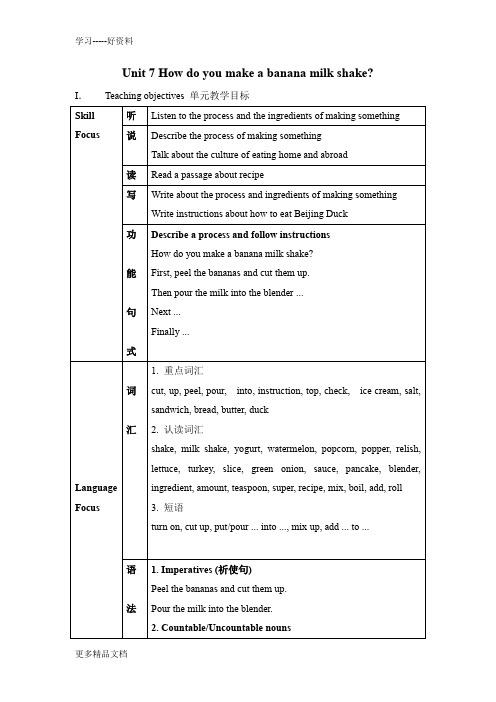
Unit 7 How do you make a banana milk shake? I.Teaching objectives 单元教学目标II. Teaching materials analyzing and rearranging 教材分析和教材重组1. 教材分析本单元的中心话题是Cooking at home,主要围绕How do you make a banana milk shake?这一主题展开各种教学活动。
并以这一主题引出可数名词和不可数名词,how many/how much 问句及祈使句等语言功能。
本单元旨在让学生学会描述制作某个东西的过程和步骤,进而分析中西方在饮食文化方面的不同,通过听、说、读、写来培养学生综合运用这些知识的能力。
最终让学生能在“做中学”(learning by doing),通过有限的课堂实践活动,能准确地用英语来表达。
Section A 1a介绍本单元的重点词汇:一些用以描述香蕉饮料的制作过程的动词,并让学生根据图片选择正确的动词完成图中句子,由此引入本单元的主题;1b让学生听一段对话录音,根据听到的顺序给句子排序,帮助学生从听力材料中了解、获取目标语言;1c是一个口头会话练习(结对子活动),指导学生如何用目标语言进行对话(描述香蕉饮料的制作过程);2a和2b是两个听力活动,通过听力训练帮助学生进一步了解目标语言的用法,落实听与写的技能目标;2c 是结对子口语会话活动,从描述如何制作香蕉饮料扩展到如何制作水果色拉,以巩固目标语言,是对学生的一种语言输出练习;3a要求学生阅读对话,并用所给的词完成对话,掌握几个表顺序的副词的用法;3b要求学生根据3a中的对话示范,看图向同伴描述爆米花的制作过程,帮助学生进一步用目标语言进行口头表达;4 是一个写食谱、拼食谱的游戏活动,给学生提供了一个学以致用的机会,是学生运用目标语言进行听、说、读、写的综合训练。
Section B 1a让学生写出自己喜欢的三明治配料并与其他学生比较,学习一些表食品的词汇,为后面的课堂活动作铺垫;1b是在1a基础上的口头训练,仿照对话与同伴谈论喜欢的三明治配料;2a和2b是两个听力练习,其中2b也有写的训练;2c又是一个结对子口头会话练习,要求学生描述自己最喜欢的三明治的制作过程,是对目标语言的巩固与扩展;3a、3b和3c为读、写训练,通过一系列活动了解中西方饮食文化的差异,其中3a是一篇关于Recipe的阅读材料,要求学生根据材料内容写出“Super Chicken Sandwich”的配料并进行分类完成表格,是一项巩固词汇的读写训练;3b是在3a的基础上的读与写的训练,完成A recipe for Sandwich的阅读语言材料;3c用目标语言进行写作的训练,落实与巩固写的技能;4是一项口语训练活动,体现了英语语言“在做中学,在学中用”的特点,本单元的综合语言知识能力的运用在此体现出来。

新目标英语八年级(上)unit7 How do you make a banana milk shake?集体备课教案教学目标:语言目标:掌握可数名词和不可数名词和How much/ How many引导的特殊疑问句。
能力目标:Listening: 听懂制作一种食品的对话材料。
Speaking: 能够描述制作一种家庭食品的过程。
Reading: 能读懂介绍食谱的文章。
Writing: 能写出重点词语和重点句型,并能写出自己最喜欢的食物食谱。
情感目标:通过对食品制作方法的学习,激发学生的学习兴趣。
语言结构:Imperatives.Countable/uncountable nouns.How much/how much questions.语言功能:Describe a process.Follow instructions.教学重点:祈使句。
区分可数和不可数名词。
How many /how much引导的疑问句。
教学难点:How many和how much之间的区别。
能够选择恰当的动词描述制作一种家庭食品的过程。
学习策略:作猜测,进行连续性的描述。
教学辅助:Tape-recorder, cards课时:Five Periods参加人员: 李小娥夏旗红朱敏丽张杰张娜段段双任文清Period OnePeriod II. Teaching aims and demands:Students learn to describe a process and follow instructions.II. Teaching contents: 1a, 1b and 1c, Section A.III. Teaching key and difficult points:Vocabulary:Shake, turn on, cut up, drink ,peel, pour, put, drink,blender, milk shake, intoTarget language:How do you make a banana milk shake?Peel the bananas. Cut up the bananas. Put the bananas and ice cream into the blender. Pour the milk in the blender. Turn on the blender. Drink the milk shake.教学后记:Period TwoI. Teaching aims and demands :Students learn to describe a process and follow instructions by guided listening and writing practice.II. Teaching contents: 2a, 2b,2c and Grammar Focus, Section A.III. Teaching key and difficult points:Vocabulary:yogurt, teaspoon, ingredient, cup, watermelon, amounthow much, how many, one teaspoonTarget language:How do you make a banana milk shake?Peel the bananas,Cut up the bananas,Put the bananas and the yogurt in the blender,Pour the milk in the blender,Turn on the blender;Drink the smoothie.How much yogurt do you need?How many apples do we need?教学后记:Period ThreeI. Teaching aims and demands:Students learn to describe a process and follow instructions by reading and writing.II. Teaching contents: 3a, 3b and 4, Section A.III. Teaching key and difficult points:Vocabulary:first, next, then, finally, mix up, cut up, p ut…in/ into, turn on, popcorn, popper, sauce, ovenTarget language:How do you make fruit salad ?First cut up…. Next put …in …. Then…. Finally mix it all up .教学后记:Period fourI. Teaching aims and demands :Students learn to describe a process and follow instructions.II. Teaching contents: 1a, 1b, 2a, 2b and c, Section B.III. Teaching key and difficult points:Vocabulary:bread, slice, turkey, relish , meat, other, sandwich, tomato sauce, mustard Target language:How many tomatoes? How much mayonnaise?First, next, then, finally.教学后记:Period FiveI. Teaching aims and demands:Students learn to describe a process and follow instructions by reading and writing a recipe.II. Teaching contents: 3a, 3b, 3c and self check, Section B.II. Teaching key and difficult points:Vocabulary:super, recipe, green onion, a slice of , add , lettuce , relish , top, pancake Target language: Describe a process.教学后记:。
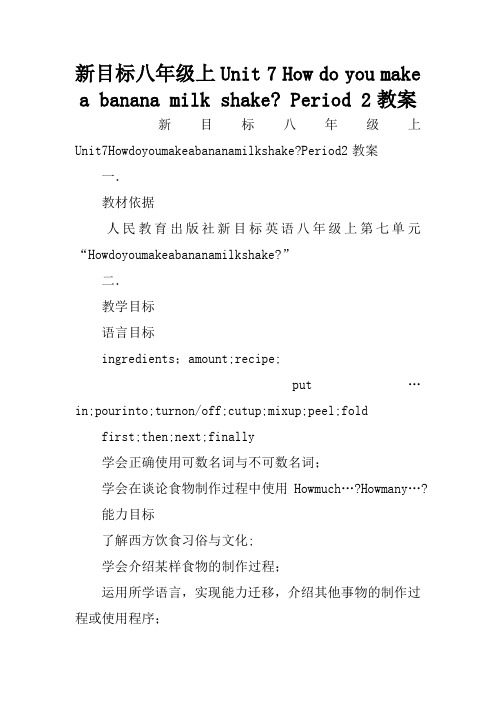
新目标八年级上Unit 7 How do you make a banana milk shake? Period 2教案新目标八年级上Unit7Howdoyoumakeabananamilkshake?Period2教案一.教材依据人民教育出版社新目标英语八年级上第七单元“Howdoyoumakeabananamilkshake?”二.教学目标语言目标ingredients;amount;recipe;put…in;pourinto;turnon/off;cutup;mixup;peel;fold first;then;next;finally学会正确使用可数名词与不可数名词;学会在谈论食物制作过程中使用Howmuch…?Howmany…?能力目标了解西方饮食习俗与文化;学会介绍某样食物的制作过程;运用所学语言,实现能力迁移,介绍其他事物的制作过程或使用程序;跨学科学习美术:制作请柬;艺术:在圣诞晚会上准备表演一个拿手的节目电脑信息:教人如何上网;社会实践:为孤儿院的小朋友开西式自助餐圣诞晚会三.语言结构:祈使句的运用;使用描述事物发生先后顺序的词语,如:first,next,then,finally;可数与不可数名词的计量。
四.语言功能:叙述某种食物或饮品的制作过程;询问和谈论所需配料及数量。
五.学习策略与思维技巧:学会合作学习,努力开拓课程资源。
六.重点词汇:milkshake,fruit/vegetablesalad,popcorn,turkey/chick ensandwiches,Beijingduck,acupof,chopsticks,teaspoonsof,pancake,slicesofbread,cutup,peel,pour…into,put…in,mixup,boil,add…to,roll,turnonfirst,next,then,finally七.任务型活动:八.教学过程:Task1:GetingredientsreadyforapartystepsTeachers’ActivitiesStudents’ActivitieswhysStep1Dowarming-upactivity.Playavideothechildrenintheorphanage.Letthestudentssaysth.afterwatchingit.Singthesong”jingleBells”together.watchthevideoandhaveashorttalkaboutwhatyouthinkofit andwhatwecandoforthem.Enliventheatmosphere.Leadintothescene.Reflectthehappinesswehaveandtakecareofit.Step2Givesomeadvicetothestudents,advisethemtohaveachrism aspartyforthechildren.Firstpreparesomefoodorothergi fts.Givesomenewwordsaboutingredients.Groupwork.Dividethestudentsto10groups.Askandansweringroups:whatpresentshallweprepare?why?whatingredients/toolsdoweneed?Learnsomecountableoruncountablenouns.Expressyourownopiniontomaketheothersofthegroupagree withyou.Fosterstudents’abilityinusinglanguage.Thinkitoverbeforeyoubegintodosomething.Learnfromtheknowtotheunknown.Step3 walkaroundandfindtheproblemwhenthestudentsarediscussingtheamount.inghowmanyandhowm uch.Practicethetargetlanguage “howmany/howmuch”.Duringthediscussingofingredient sandamount,thestudentswilldecidetheamountofingredie ntsaccordingtotheamountofpeople.Task2TeachthechildrenintheorphanagetomakesomethingStepsTeacher’sActivitiesStudents’ActivitieswhysStep1Presentsomepicturesofthefoodortheotherthingswhatthe studentsprepare.Ask:canyouteachthemhowtomakeit?Givesomeusefulverbs.movearoundandofferlanguagehelpifnecessary.workingroups:Discusshowtomakethefood.Learntousedifferentverbstodescribletheprocedures.Arousestudents’learningenthusiasm.Givestudentsachanceoflearningbydoing.Step2Askstudentstowritetheproceduredown.Usingfirst,next,then,finallyPracticewriting.Atfirstwritebyyourself.Thenchangeandcheckyourlittlecompositionwiththeother sinthegroup.makesurewhoseisthebest.Providewritingpracticeusingthetargetlanguage.Learntohelpstudyeachother.Fosterstudents’abilityincooperation.Pavethewayforfurtherspeaking.Step3Invitesomegroupstoreport.Asktheothergroupsafewquestionsaboutthereport.Groupleadersgivereportstothewholeclassonebyone.Theotherslistentothereportsandanswerthequestions.Providespeakingandlisteningpractice.Learnfromeachother.Task3GetthepartystartedStepsTeacher’sActivitiesStudents’ActivitieswhysStep1It’stimetogetourpartystarted.Enjoythesong“you‘dbettergetthepartystarted”fromPink.Preparefortheparty.Standupandcheer.Enliventheatmosphere.callstudents’enthusiasmoflearningEnglish.Step2Pleaseshowthechildrenyourtalentsactively.Encourgeallofthestudentstocomebeforetheclass.Don’tbeshyornervous.Haveacompetitionbetweenboysandgirls.whichteamismoreactiveortalented?Advocatestudythroughpractice,participation,cooperationandcommunication.Step3Assignmentmakeakindoffoodthatyoulearnttodayforyourparentsatho meandtellyourparentswhatthewesternsliketoeatandhowt omakethem.consolidateandknowmoreaboutwesterncountries.Emotioneducation:Lovethepeoplearoundus.教学流程教学后记:这节综合活动课首先创设了一个情境,即为孤儿院送温暖,举办一台自助式圣诞晚会。
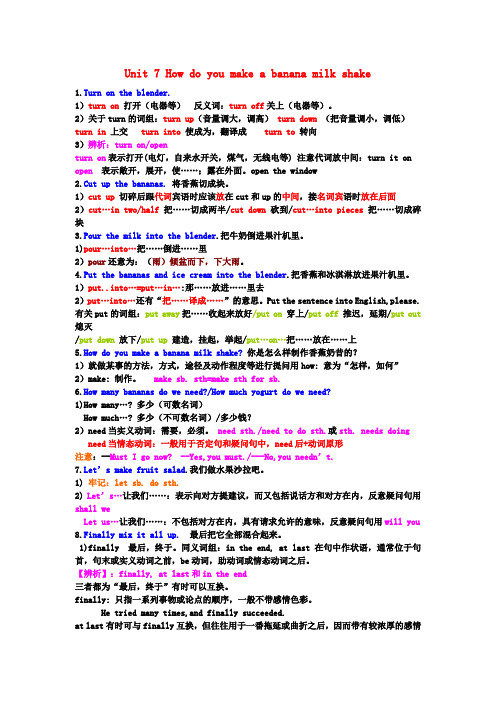
Unit 7 How do you make a banana milk shake1.Turn on the blender.1)turn on打开(电器等)反义词:turn off关上(电器等)。
2)关于turn的词组:turn up(音量调大,调高)turn down(把音量调小,调低)turn in上交 turn into使成为,翻译成 turn to转向3)辨析:turn on/openturn on表示打开(电灯,自来水开关,煤气,无线电等) 注意代词放中间:turn it on open表示敞开,展开,使……;露在外面。
open the window2.Cut up the bananas.将香蕉切成块。
1)cut up切碎后跟代词宾语时应该放在cut和up的中间,接名词宾语时放在后面2)cut…in two/half把……切成两半/cut down砍到/cut…into pieces把……切成碎块3.Pour the milk into the blender.把牛奶倒进果汁机里。
1)pour…into…把……倒进……里2)pour还意为:(雨)倾盆而下,下大雨。
4.Put the bananas and ice cream into the blender.把香蕉和冰淇淋放进果汁机里。
1)put..into…=put…in…:那……放进……里去2)put…into…还有“把……译成……”的意思。
Put the sentence into English,please. 有关put的词组:put away把……收起来放好/put on 穿上/put off 推迟,延期/put out 熄灭/put down放下/put up建造,挂起,举起/put…on…把……放在……上5.How do you make a banana milk shake? 你是怎么样制作香蕉奶昔的?1)就做某事的方法,方式,途径及动作程度等进行提问用how: 意为“怎样,如何”2)make: 制作。

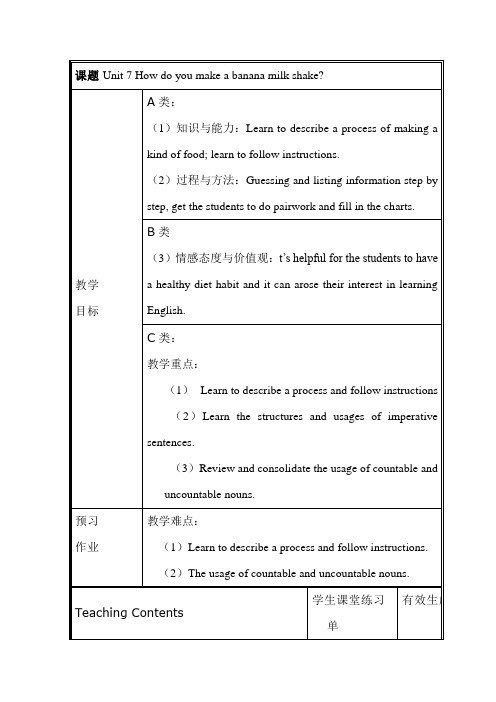
课题Unit 7 How do you make a banana milk shake?教学目标A类:(1)知识与能力:Learn to describe a process of making a kind of food; learn to follow instructions.(2)过程与方法:Guessing and listing information step by step, get the students to do pairwork and fill in the charts.B类(3)情感态度与价值观:t’s helpful for the students to have a healthy diet habit and it can arose their interest in learning English.C类:教学重点:(1)Learn to describe a process and follow instructions (2)Learn the structures and usages of imperative sentences.(3)Review and consolidate the usage of countable and uncountable nouns.预习作业教学难点:(1)Learn to describe a process and follow instructions.(2)The usage of countable and uncountable nouns.Teaching Contents学生课堂练习单有效生成第一.二课时Section A 1a---4Step1. Greet the class as usual.Step2. Lead-in: The teacher show the slide ofblenders, and ask:What are these? They’re blenders. What do we usually use them to do ?To make juice, apple juice, orange juice and so on. It is said that banana milk shake is very delicious. Do you know how to make banana milk shake?Today we’re going to learn how to make a banana milk shake. (show a slide---unit 7)Step3. 1a Now open your books at page 41 , 1a . Look at the picture What can you see ? The picture shows some actions. What are these actions? Now let’s read the words in 1a. Follow me, please. Ask Ss to write the names of the actions on the blanks. Check the answers.Step 4: 1b Play the recording for the first time, students just listen. Play the recording a Look some pictures and say something about them理解并掌握做奶昔的步骤Check the answers.second time, this time , Number the instructions from 1 to 6. Correct the answers.Get the students to read the instructions in the right order.Step5: 1c Pairwork: First show the slide, say the steps of making a banana milk shake together, then work in pairs. Ask somestudents to say the steps according to the pictures.Step6: 2a. Before listening, show the slide about countable and uncountable nouns. Next, listen to the tape and fill in the chart. Check the answers. Show the slide about “how many and how much”.Step7: 2b Before listening, show the slide about countable and uncountable nouns (II); Listen again, fill in the chart.Check the answers.Step8: 2c Pairwork课堂总结:Today we learned how to make a banana milk shake and fruit salad.If you want to drink sth. or eat sth, you could make a special one , not by work in pairs.listen to the tape and fill in the chart.Listen again, fill in the chart.Check the answers.your father or mother, but by yourself. There is alot of fun in cooking.板书:Unit 7 How do you make a banana milk shake? Cut up How many bananas do weneed?Put… in… We need three bananas.Turn on We need one teaspoon ofyogurtTurn on We need one teaspoon ofyogurt.作业:List the instructions of making a banana milk shake and the ingredients of making fruit salad.第三.四课时Section B 1a---4教学步骤:Step 1 Lead-in (导入)Do warming-up activity.Play a video the children in the orphanage.Let the students say sth. after watching it.Step 2Give some advice to the students ,advise them to -Sing the song”Jingle Bells”togethe Watch the video and have a short talkhave a Chrismas party for the children.First prepare some food or other gifts.Give some new words about ingredients.Step 3Walk around and find the problem when the students are discussing the amount.Step 4Present some pictures of the food or the other things what the students prepare.Ask :Can you teach them how to make it?Give some useful verbs .Move around and offerlanguage help if necessary.Step 5Ask students to write the procedure down.Using first,next ,then ,finallyStep 6Invite some groups to report.Ask the other groups a few questions about the reportStep 7Make a kind of food that you learnt today for your parents at home and tell your parents what the about what youthink of it andwhat we can dofor them.Groupwork.Dividethe students to10 groups.Ask and answer in groups:Act out theirdialogue of discussion.Using howmany and howmuchLearnto helpstudyeachother.Fosterstudents’abilityincooperwesterns like to eat and how to make them.课后反思:由于所设情境贴近生活,有“吃”又有“玩”,学生们充分体会到了学习的乐趣和成功的喜悦,为他们的终生学习奠定了较好的基础。



Unit 7 How do you make a banana milk shake?[教学内容] :Unit 7 How do you make a banana milk shake?[设计思路]本节课通过三个任务的完成,引导学生如何去描述做一件事的过程。
在完成任务的过程中,综合运用目标语言,并通过与他人的合作交流,提高他们的团队合作意识。
整个教学过程倡导用自主,参与,合作,交流,实践,探究的学习方式和任务型的教学途径培养学生综合运用语言的能力,有易到难,有模拟任务到真实任务,从而完成语言学习及运用的过程.[教学目标]1.知识目标:掌握有关水果的词汇,区分可数和不可数名词,学会用how many/how much问句,并学会用first,next,then,finally来描述过程2.能力目标:通过这堂课学会如何去动手做食物,并且如何去描述其过程3.文化目标:了解中国饮食文化和其他国家的不同[语言功能]1.能够谈论不同国家的饮食文化2.了解更多的水果名称3.能够谈论自己喜爱的食物4.能够陈述制作食物的过程[学习策略]1.培养学生自主学习的能力。
2.有效地利用学习资源。
3.通过合作学习,启发学生的思维,培养学生的动手能力和合作精神。
[重点词汇]First, next, then, finally, cut up, peel, turn on, salad[语言目标]1.How do you make…?2.How many apples do we need?3.How much milk do we need?4.First, cut up the bananas.5.Then, …[跨学科学习]1.社会实践:制作食物2.文化:了解其他国家的饮食文化Teaching procedureDiagram of tasks:。
Unit 7 How do you make a banana milk shake? I.Teaching objectives 单元教学目标II. Teaching materials analyzing and rearranging 教材分析和教材重组1. 教材分析本单元的中心话题是Cooking at home,主要围绕How do you make a banana milk shake?这一主题展开各种教学活动。
并以这一主题引出可数名词和不可数名词,how many/how much 问句及祈使句等语言功能。
本单元旨在让学生学会描述制作某个东西的过程和步骤,进而分析中西方在饮食文化方面的不同,通过听、说、读、写来培养学生综合运用这些知识的能力。
最终让学生能在“做中学”(learning by doing),通过有限的课堂实践活动,能准确地用英语来表达。
Section A 1a介绍本单元的重点词汇:一些用以描述香蕉饮料的制作过程的动词,并让学生根据图片选择正确的动词完成图中句子,由此引入本单元的主题;1b让学生听一段对话录音,根据听到的顺序给句子排序,帮助学生从听力材料中了解、获取目标语言;1c是一个口头会话练习(结对子活动),指导学生如何用目标语言进行对话(描述香蕉饮料的制作过程);2a和2b是两个听力活动,通过听力训练帮助学生进一步了解目标语言的用法,落实听与写的技能目标;2c 是结对子口语会话活动,从描述如何制作香蕉饮料扩展到如何制作水果色拉,以巩固目标语言,是对学生的一种语言输出练习;3a要求学生阅读对话,并用所给的词完成对话,掌握几个表顺序的副词的用法;3b要求学生根据3a中的对话示范,看图向同伴描述爆米花的制作过程,帮助学生进一步用目标语言进行口头表达;4 是一个写食谱、拼食谱的游戏活动,给学生提供了一个学以致用的机会,是学生运用目标语言进行听、说、读、写的综合训练。
Section B 1a让学生写出自己喜欢的三明治配料并与其他学生比较,学习一些表食品的词汇,为后面的课堂活动作铺垫;1b是在1a基础上的口头训练,仿照对话与同伴谈论喜欢的三明治配料;2a和2b是两个听力练习,其中2b也有写的训练;2c又是一个结对子口头会话练习,要求学生描述自己最喜欢的三明治的制作过程,是对目标语言的巩固与扩展;3a、3b和3c为读、写训练,通过一系列活动了解中西方饮食文化的差异,其中3a是一篇关于Recipe的阅读材料,要求学生根据材料内容写出“Super Chicken Sandwich”的配料并进行分类完成表格,是一项巩固词汇的读写训练;3b是在3a的基础上的读与写的训练,完成A recipe for Sandwich的阅读语言材料;3c用目标语言进行写作的训练,落实与巩固写的技能;4是一项口语训练活动,体现了英语语言“在做中学,在学中用”的特点,本单元的综合语言知识能力的运用在此体现出来。
Self check 1 检验学生对几个重要动词和动词短语的掌握情况,形式为填空和造句;2 要求学生根据所给图片和提示语写一段吃北京烤鸭的步骤和过程,是对学生语言应用能力的综合检验。
2. 教材重组和课时分配Period 1(Section A: 2a, 2b, Section B: 1a,1b)Function, Listening and SpeakingPeriod 2(Section A: 1a, 1b, 1c, 2c, 3a, 3b, 4)Function and Integrating skillsPeriod 3(Section B: 2a, 2b, 2c, 3a, 3b, 3c)Integrating skills and CulturePeriod 4(Self check and some exercises)Grammar and PracticeIII. Teaching plans for each period分课时教案Period 1 Function, Listening and SpeakingTarget language 目标语言1. Words and phrases生词和短语shake, watermelon, yogurt, teaspoon, blender, salt, popcorn, popper, sandwich, butter,relish, sauce, turkey, slice, green onion, duck, pancake, ingredient, instruction, amount 2. Key sentences重点句子How many bananas do we need?How much milk do we need?Ability goals 能力目标Get students to know the names of food and drink, the plural forms of countable nouns, and uncountable nouns.Learning ability goals 学能目标Help students learn how to eat healthy.Teaching important and difficult points 教学重难点The use of countable nouns and uncountable nouns.Teaching aids 教具准备CAI or lantern slides, pictures, tape recording.Teaching procedures and ways 教学过程与方式Step I Warming upT: Good morning, boys and girls! Do you like English songs? Let’s relax ourselves and enjoy an English song: “One hamburger, two hamburgers ...”(CAI呈现)T: What’s the song about?Ss: Food and drink.T: Yeah, great! In this unit we’ll talk about how to make delicious food and drink. (Write “How to make things”on the blackboard.) Today we will learn the names of food and drink first.Step II Guessing game and PresentationT: Now please tell me what kind of food/drink/fruit you like.S1: I like noodle.S2: I like bananas.S3: ...In this way, help students to review the words about food they have learned. Thenteach the following new words by using pictures or slides.Sample pictures:Step III Make chantsT: I have a good way to remember the words well. Now look at the slide and chant after me.Show the following on the slide.T: OK. Now make your own chants by changing the words underlined with the new words that we have learned.Students make chants with each other, then ask individual students to present their chants to the class and see who does it best.Then choose the best chant maker and the best chanter.Step IV Countable nouns and uncountable nounsShow the following words on the screen.1.Put the words into the correct placesT: Now please look at the words carefully. Then tell us which words can be counted and which words can not be counted. Put them in the right places in groups of four. After that have the students make a conclusion on the rules of plural forms of countable nouns and uncountable nouns. Finally sum up about the rules that: Countable items are things you can count like one apple, two apples, three bananas; Uncountable items are things you can’t count like milk or yogurt. So you should say some milk/yogurt or two cups of milk/yogurt.2. PairworkAsk a student to act as partner, and present the following dialogue as a model. Then let students make more similar dialogues with the words above.Model:T: How many bananas do we need?S: Three bananas.T: How much relish do we need?S: Two teaspoons.Step V Listening (Section A: 2a, 2b)In this step students will do some listening, speaking and writing practice using the target language.T: Maria and Katie are making a fruit salad. Listen carefully to what they’re talking about.Play the recording for the first time. Students only listen.T: They mentioned some names of foods, right? We call them ingredients. Look at thechart in 2a on page 42. (Call attention to the h eadings “How much” and “How many”) Write the ingredients you can count under the heading “how many” and write those you can’t count under the heading “how much”.Play the recording again, students listen and write the names of the ingredients in the correct column.Check the answers.Then point at the chart in 2b and ask a student to read the amounts in the first column. Point out the measuring cup and teaspoon in the picture above.T: Listen to the recording again. This time listen to the amount of each ingredient the girls talk about. Write the name of each ingredient after the amount in the chart.Play the recording again. Students write words in the correct places in the Ingredient column.Then check the answers.T: Now look at the sample conversation in the picture. Which pair would like to read the conversation for us?Ask two students to read it to the class. Enable them to read in proper tone and intonation.Then let students make similar dialogues with the ingredients and the amounts in the chart in pairs.Finally, have some pairs present their dialogues.Step VI My favorite (Section B: 1a, 1b)Show the followings on slide.T: Now discuss in groups of four. Take turns to ask your partners what he or she likes in sandwiches/popcorn/smoothie/ ... Each group can choose one food and talk about it, then report to the class.Finally make a comment and choose:※the best reporter※the best salad※the best smoothie※the best sandwichStep VII Summary and HomeworkT: Today we have learned some names of food, what ingredients we need to make things and how many/how much of them we need. Most of you talked about your favorite food as well. But I don’t think you can eat everything that you like. We should have healthy eating habit.Homework:Your class is having a party. You want to make some fruit salad and sandwiches. So your classmates and you are shopping. Yon are talking about what you need and the amount.Please make a shopping list.Period 2 Function andIntegrating skillsTarget language 目标语言1. Words and phrases生词和短语peel, cut, pour, cut up, turn on, pour ... into, boil, add, add ... up, mix ... up, finally 2. Key sentences重点句子(1) How do you make a banana milk shake?First, peel the bananas and cut them up.Then put the milk into the blender ...First ... next ... then ... finally ...(2) How do you make fruit salad?(3) How do you make popcorn?Ability goals 能力目标Learn the adverbs of procedure: first, next, after that, then, finally etc.Talk about making food.Learning ability goals 学能目标Help the students learn how to describe a process with the target language. Teaching important and difficult points 教学重难点Describe the process of making something.Teaching aids 教具准备CAI or lantern slides, stick figures, tape recording.Teaching procedures and ways 教学过程与方式Step I Verbs and instructions (Section A: 1a, 1b)Talk about the picture on page 41.T: Look at the picture carefully. What can you see? What are the boys doing?First have some individuals answer the question.Clue: The picture shows some actions.Then help students to learn the meanings of the following verbs and verb phrases: peel, cut, pour, cut up, turn on, pour ... into, boil, add, add ... up, mix ... upThen let students do activity 1a.Check the answers and let them remember the actions:A. Drink the milk shakeB. Pour the milk into the blenderC. Peel the bananasD. Cut up the bananasE. Turn on the blenderF. Put the bananas and ice cream in the blenderT: From the picture, can you guess what they are doing?Ss: They’re making a banana milk shake.T: Yeah, you are clever. They are making smoothie.Then deal with the listening activity 1b. This activity gives students practice in understanding the target language in spoken conversation, especially students’ ability of solving and analyzing information.T: Now let’s do some listening. It’s about some instructions of making a banana milk shake. First read the list of actions in activity 1b before listening.Ss: (Read)T: Do you know how to make banana milk shake? Can you put these instructions in correct order? ... Now listen to the conversation, number the instructions in the correct order.Play the recording. Students listen and number the instructions.Play the tape again. Students listen and check the answers.Step II Pairwork (Section A: 1c)T: Do you know how to make a banana milk shake now?Ss: Yes.Present the conversation with an individual as a model.T: How do you make a banana milk shake, Xiao Li?L: Peel the bananas, cut up the bananas, put the bananas and ice cream into the blender ...Then let students practice the conversation in pairs without looking at the instructions.Step III Writing (Section A: 3a)This activity provides reading and writing practice using the target language.T: Now let’s move on to 3a on page 43. First look at the picture carefully and answer my question: What are the girl and the woman doing?Ss: They are making fruit salad.T: What ingredients can you see in the picture?Ss: Apples, bananas, watermelon, honey and yogurt.T: In the box, there are four words. Now read together. (...) We can use these words to describe a process. They tell the order of instructions. Which word always comes first?Ss: First.Ask students to put number 1 next to the word “first”. Then ask them to number the other three words to show the order they appear in a process.Clue: first →next →then →finallyT: Now please write these words in the blanks.Check the answers.Ask a pair to read the conversation to the class.Step IV Consolidation (Section A: 3b)This activity provides guided oral practice using the target language.T: Next we will make another kind of food. Kids in America like that very much. I think you like it, too.Show a picture of popcorn.T: Look at my picture please. Do you like it? (...) I like it, too. It tastes delicious. Nowlet’s go over some new words about the delicious food first.Show the following on the screen and let students repeat.T: Now look at the pictures in activity 3b on page 43. Can you tell me what is happening in Picture 1?S: One of the boys puts the popcorn into the popper.T: How about Picture 2? What do they do?S: They turn on the popper.Deal with Pictures 3, 4, 5 in the same way.T: Now you can work with a partner. Tell your partner how to make popcorn.Then ask one or two students to tell the class how to make popcorn.Sample process of making popcorn:First, put the popcorn into the popper.Next, turn on the popper.Then, pour the popcorn into the bowl.After that, put some salt on the popcorn.Finally, enjoy it!Step V Game (Section A: 4)This activity provides listening, speaking, reading, and writing practice using the target language.T: Now let’s play a game. Get into group of four or six.Help students form teams and read the instructions to the class.T: Now listen to me carefully and clearly. First decide on a dish or food your group members all like. Then work out a recipe for it and write it down. Use the words first, next, then, and finally in your recipe.As the groups work on their recipes, move around the room checking their work. Help with names and amounts of ingredients as well as names of kitchen items. Also help students keep the vocabulary as simple as possible, using words that the class already know.Remind them to write each instruction on a separate line.T: Now cut your recipe up. And exchange it with another group. Then put the recipe you get in order. Are you clear?A few minutes later, ask the groups to check each other’s work. In the end, ask some groups to read their recipes to the class. V ote for the most creative food.Step VI Summary and HomeworkT: This class we have learned how to make a banana milk shake, how to make fruit salad and how to make popcorn. We also learned how to describe a process by using “first, next, then and finally”. I hope you can make these foods at home by yourselves. It will be fun.Homework:Search for information about the eating habits and culture in western countries.Period 3 Integrating skills andCultureTarget language 目标语言1. Words and phrases生词和短语butter, turkey, slice, relish, lettuce, onion, sandwich, add, add ... up, mix ... up, finally 2. Key sentences重点句子How do you make a sandwich?First, put some relish on a slice of bread.Then cut up some tomatoes ...Finally, ...Ability goals 能力目标Learn to write the process of making something.Learning ability goals 学能目标Help students learn how to describe the steps of making something in English correctly.Teaching important and difficult points 教学重难点How to write a recipe.Teaching aids 教具准备CAI, tape recording.Teaching procedures and ways 教学过程与方式Step I Revision and PresentationT: Last class we learned how to make smoothie, fruit salad and popcorn. Do you remember the instructions of making them?Ask students to bring materials for making milk shake, salad or sandwich. Then have the students talk about their favorite food.Finally, three individuals describe the steps of making smoothie, fruit salad and popcorn.Show the steps of making popcorn on the slide and have students read together.How to make popcorn:First, put the popcorn into the popper.Next, turn on the popper.Then, pour the popcorn into the bowl.After that, put salt on the popcorn.Finally, eat the popcorn!T: Well done! This class we will make another different food. It is more delicious and tasty, but more difficult to do. Now let’s learn some new words we will use to make a more delicious sandwich. Please look at the screen and read after me.Show on the screen:Words and meanings:butter, turkey, slice, relish, lettuce, onion, sandwich,add, add ... up, recipe, mustard add: put something on (doing action to show)recipe: ways to cook food, with this we could cook food as easily as a real chef mustard: something we put into salad or food to make more flavorStep II Listening (Section B: 2a, 2b)Show a picture of a sandwich.T: Do you like it? What ingredients do we need to make it?Ss: ...T: Now let’s look at activity 1a on page 44.Point to the food in activity 1a and read the words to the class.T: You will hear some of these words on the tape. Now listen and circle the words that you hear.Play the tape twice. Then check the answers.Call attention to the chart in activity 2b.T: Listen again carefully and write down the ingredients in the order you hear them. Play the tape twice and then check the answers.Step III Pairwork (Section B: 2c)T: Have you got some ideas about how to make a turkey sandwich after listening? Ss: ...T: Well, I will tell you more about it. First please take out a piece of paper. Then write down the things you use to make your favorite sandwiches. And don’t forget the amount. Clear?Then students write down the ingredients and amount they need for their favorite sandwich.T: OK. Now work in pairs. Use your list of ingredients and amounts to tell your partner how to make your favorite sandwich. Remember to use the words “First, Next,Then, and Finally.”Point out the sample conversation on page 44 and have the students read it together. Then students make their own conversations.Ask some pairs to present their conversations to the class in front.Step IV Reading (Section B: 3a)T: Now let’s read a recipe of making a super chicken sandwich.Point to the recipe and the chart below it.T: We know onion is a kind of vegetable. What about tomato?S: It’s a kind of vegetable, too.T: Is chicken slice vegetable or meat?S: Meat.Point to the words “Vegetables”, “Meat”, and “Others” in the chart. Ask students to give some examples for each type of food.T: You are very clever. Now read the recipe and write the ingredients under “Vegetables”, “Meat”, and “others” in the chart below.Then check the answers.Then call attention to the ingredients list. Let students underline the names of ingredients and circle the amounts. This will help them to review uncountable nouns and countable nouns.bread →two slicesbutter →1 teaspoononion →1tomato →1chicken →3 slicesrelish →2 teaspoonsStep V Writing (Section B: 3b, 3c)1. Read the recipe and fill in the blanks with the words from the box.T: There is another sandwich recipe. It’s for a great turkey sandwich. Read the recipeand fill in the blanks with the words from the box on the left.Point out the words in the box and ask a student to read the words to the class. Check the answers.2. PairworkRead the instructions to the class. Then ask:T: What should we do before we make some food?Ss: Write out the ingredients.T: Very good! Now write down the ingredients you need to make your favorite food, and then write your recipes. You can use the recipe in activity 3b as an example. After students have finished, ask them to read their recipes to their partners and check each other.Finally, ask some students to read their recipes to the class.Step VI Eating cultureIn this step, students will learn something about the eating culture in the west.Show the followings on slide.Differences between the western and Chinese eating culture1. Cooking waysIn China:Pay attention to color, smell, taste; Cook with cooking pot, has much smoke; Different ways of cooking: stew, braise, fry, instant boil, smoke; deep fry, simmer;In western countries:Pay attention to nutrition; Cook with oven, doesn’t have too much smoke;Simple cooking ways: roast, bake, toast, boil;2. Eating habitsIn China:1) Eat with chopsticks.2) Take vegetables from the same plate with own chopsticks.In western countries:1) Eat with forks and knives.2) Take food from own plate.3. Eating mannersIn China:1) People can talk loudly when they are eating.2) People throw up the draffy after eating.3) A guest in a Chinese house never finish the food, he leaves a little to show that he has had enough.In western countries:1) People speak softly when they are eating.2) People never throw up the draffy.3) In England, a guest always finishes a drink to show that he has enjoyed it.4. Order of servingsIn China:1) cold dishes and drinks2) main courses—fish; crabs; shrimps; pork; chicken; vegetables3) fruitsIn western:1) starters—soup/cocktail2) main courses—chicken; steak; lamb; fish; pork; hamburgers;3) drinks—mineral water; coffee; juice;Show some pictures of western food on the slide, let students know some dishes abroad.Step VII HomeworkSuppose one of your foreign friends is visiting China. He asks you for some recipes of typical Chinese food such as dumpling, Yangzhou fried rice, noodles, Zongzi and so on. Please choose one and write a recipe for him.Period 4 Grammar and ExercisesTarget language 目标语言1. Words and phrases生词和短语Review all the words and phrases in this unit.2. Key sentences重点句子How much yogurt do we need?How many tomatoes do we need?How do you make a sandwich?First, put some relish on a slice of bread.Next, cut up some tomatoes ...Then ...Finally ...Ability goals 能力目标Review the vocabulary and target language and put them into use.Learning ability goals 学能目标Help students to review what they have learned in this unit through self check. Teaching important and difficult points 教学重难点How to make sentences with some key words in this unit.Describe the process of making something fluently.Teaching aids 教具准备CAI, lantern slides.Teaching procedures and ways 教学过程与方式Step I Memory challenge1. Use the pictures in Period 1 to review all the words of nouns in this unit. (CAI呈现)2. Show the exercise on the slide:A Countable Nouns C Uncountable NounsBStep II Self check1. Activity 1 (This activity focuses on some verbs and verb phrases introduced in this unit.)T: Look at activity 1 on page 46. Here are five blanks. Fill in the blank with the words given.Students work alone to fill in the blanks. When they’ve finished, ask some students to read their completed sentences. Correct any mistakes they may have. Then let students make their own sentences with the words given.2. Activity 2 (This activity provides writing practice using the target language of the unit.)Read the instructions to the class. Ask students to write instructions based on the pictures.Sample instructions:First, check you have all the ingredients. You need sauce, green onion and slices of duck. Next, put slices of duck, sauce, green onion into the pancake.Then, roll the pancake.Finally, eat it!Step III Exercises1.Fill in the blanks with the words in the box.Thank you for ______Anna’s Cookery show. Today let’s make a pizza.________, mix 2 cups of flour, 2 spoons of butter and 1 cup of milk up to make a curst. ________, put tomato _______ on the curst._________, put green pepper, sausage and _______ on top of it. _____ that, some cheese on them. _________, bake the pizza ina hot oven for 20 ________ .2. Complete the conversation according to the passage above.A: Can you tell me how to make a pizza?B: Sure.A: _______ can I make a crust?B: You need some _________ , _________ and some milk.A: _______ milk shall I pour into it?B: _______ is enough.A: Can I ________ them up all like this?B: Yes. You do a good job. Now pour some _________on the crust. And then put the small pieces of _________, ________,_________, and _________ on top of it.A: ________, ________do I bake them in the oven?B: 20 minutes. But don’t forget to add cheese on it__________ you bake it.3. Exploring worldThis is a broken recipe for duck stew. Could you number them from 1 to 8?( )salt in it when it boils the second time.( )add four large bowls of water to cook it.( )milk. Then put some tomato sauce and a little ( )First cut three potatoes intothin slices and put them( )into the saucepan with a little duck.( )Finally cook for 40 minutes.( )After it boils, pour a cup of( )NextKey: 7-4-6-1-2-8-5-3Step IV HomeworkCollect the recipes you have learned in this unit and make a recipe booklet. Show it to your mother and help her cooking your favorite food.Teaching resources教学资源库I. 背景知识饮食文化是人类饮食方面的思想,意识和观念。